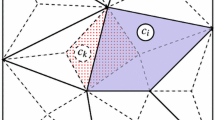Abstract
A spectral collocation scheme for the three-dimensional incompressible \(({\varvec{u}},p)\) formulation of the Navier–Stokes equations, in domains \(\varOmega \) with a non-periodic boundary condition, is described. The key feature is the high order approximation, by means of a local Hermite interpolant, of a Neumann boundary condition for use in the numerical solution of the pressure Poisson system. The time updates of the velocity \({\varvec{u}}\) and pressure \(p\) are decoupled as a result of treating the pressure gradient in the momentum equation explicitly in time. The pressure update is computed from a pressure Poisson equation. Extension of the overall methodology to the Boussinesq system is also described. The uncoupling of the pressure and velocity time updates results in a highly efficient scheme that is simple to implement and well suited for simulating moderate to high Reynolds and Rayleigh number flows. Accuracy checks are presented, along with simulations of the lid-driven cavity flow and a differentially heated cavity flow, to demonstrate the scheme produces accurate three-dimensional results at a reasonable computational cost.




Similar content being viewed by others

References
Albensoeder, S., Kuhlmann, H.C.: Accurate three-dimensional lid-driven cavity flow. J. Comput. Phys. 206, 536–558 (2005)
Bell, J., Colella, P., Glaz, H.: A second order projection method for the incompressible Navier–Stokes equations. J. Comput. Phys. 85, 257–283 (1989)
Boyd, J.P.: Chebyshev and Fourier Spectral Methods, 2nd edn. Dover, New York (2001)
Canuto, C., Hussaini, M.Y., Quarteroni, A., Zang, T.A.: Spectral Methods in Fluid Dynamics. Springer, New York (1988)
Chorin, A.: Numerical solution of Navier–Stokes equations. Math. Comput. 22, 745–762 (1968)
Deville, M., Fischer, P., Mund, E.: High-order Methods for Incompressible Fluid Flow. Cambridge University Press, Cambridge (2002)
Ehrenstein, U., Peyret, R.: A Chebyshev collocation method for the Navier–Stokes equations with application to double-diffusive convection. Int. J. Numer. Meth. Fluids 9, 427–452 (1989)
Fornberg, B.: A Practical Guide to Pseudospectral Methods. Cambridge University Press, Cambridge (1996)
Gottlieb, D., Lutsman, L.: The spectrum of the Chebyshev collocation operator for the heat equation. SIAM J. Numer. Anal. 20, 909–921 (1983)
Gresho, P.M., Sani, R.L.: On pressure boundary conditions for the incompressible Navier–Stokes equations. Intern. J. Numer. Methods Fluids 7, 1111–1145 (1987)
Henshaw, W.D., Kreiss, H.-O., Reyna, L.G.: A fourth-order accurate difference approximation for the incompressible Navier–Stokes equations. Comput. Fluids 23, 575–593 (1994)
Hesthaven, J., Gottlieb, S., Gottlieb, D.: Spectral Methods for Time-Dependent Problems. Cambridge University Press, Cambridge (2007)
Johnston, H., Liu, J.-G.: A finite difference scheme for incompressible flow based on local pressure boundary conditions. J. Comput. Phys. 180, 120–154 (2002)
Johnston, H., Liu, J.-G.: Accurate, stable and efficient Navier–Stokes solvers based on explicit treatment of the pressure term. J. Comput. Phys. 199, 221–259 (2004)
Karniadakis, G.E., Sherwin, S.: Spectral/\(hp\) Element Methods for Computational Fluid Dynamics, 2nd edn. Oxford University Press, New York (2005)
Kim, J., Moin, P.: Application of a fractional-step method to incompressible Navier–Stokes equations. J. Comput. Phys. 59, 308–323 (1985)
Kim, J., Moin, P., Moser, R.: Turbulence statistics in fully developed channel flow at low Reynolds number. J. Fluid Mech. 177, 133–166 (1987)
Ku, H.C., Hirsh, R.S., Taylor, H.D.: A pseudo-spectral method for solution of three-dimensional incompressible Navier–Stokes equations. J. Comput. Phys. 70, 439–462 (1987)
Leiriche, E.: Direct numerical simulation in a lid-driven cavity at high Reynolds number. J. Sci. Comput. 27, 335–345 (2006)
Liu, J.-G., Liu, J., Pego, R.: Stability and convergence of efficient Navier–Stokes solver via a commutator estimate. Commun. Pure Appl. Math. 60, 1443–1487 (2007)
Lynch, R.E., Rice, J.R., Thomas, D.H.: Direct solution of partial difference equations by tensor product methods. Numer. Math. 6, 185–199 (1964)
Orszag, S.A., Israeli, M., Deville, M.: Boundary conditions for incompressible flows. J. Sci. Comput. 1, 75–111 (1986)
Petersson, N.A.: Stability of pressure boundary conditions for Stokes and Navier–Stokes equations. J. Comput. Phys. 224, 1064–1094 (2001)
Peyret, R.: Spectral Methods for Incompressible Viscous Flow. Springer, New York (2002)
Sani, R.L., Shen, J., Pironneau, O., Gresho, P.M.: Pressure boundary condition for the time-dependent incompressible Navier–Stokes equations. Intern. J. Numer. Methods Fluids 50, 673–682 (2006)
Spalart, P.: Direct simulation of a turbulent boundary layer up to \(R_\theta =1410\). J. Fluid Mech. 187, 61–98 (1988)
Spalart, P.: Theoretical and numerical study of a three-dimensional turbulent boundary layer. J. Fluid Mech. 205, 319–340 (1989)
Temam, R.: Sur l’approximation de la solution des equation de Navier–Stokes Par la Méthode Des Fractionnarires II. Arch. Ration. Mech. Anal. 33, 377–385 (1969)
Trefethen, L.N.: Spectral Methods in MATLAB. SIAM, Philadelphia (2001)
Acknowledgments
This work is supported in part by NSF DMS-1115420, NSFC 11271281 (C. Wang).
Author information
Authors and Affiliations
Corresponding author
Appendix: A Derivative Formulas for Lagrange Interpolation Basis Function
Appendix: A Derivative Formulas for Lagrange Interpolation Basis Function
Given K, let \(\{l_k(y)\}_{k=0}^K\) denote the \(K\!+\!1\) Lagrange interpolation basis functions based on the \(K\!+\!1\) distinct points \(\{y_j\}_{j=0}^K\). The functions are defined by \( l_k(y) = \displaystyle { \mathop {\prod _{i=0}^{K}}_{ i \ne k} \frac{y-y_i}{y_k-y_i}},\) and satisfy \(l_k(y_j)=\delta _{k,j}\) for \(0 \le k,j \le K\). A direct calculation gives

and

Rights and permissions
About this article
Cite this article
Johnston, H., Wang, C. & Liu, JG. A Local Pressure Boundary Condition Spectral Collocation Scheme for the Three-Dimensional Navier–Stokes Equations. J Sci Comput 60, 612–626 (2014). https://doi.org/10.1007/s10915-013-9808-7
Received:
Revised:
Accepted:
Published:
Issue Date:
DOI: https://doi.org/10.1007/s10915-013-9808-7



